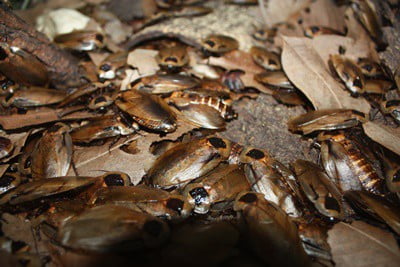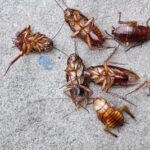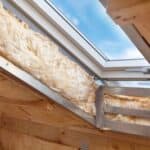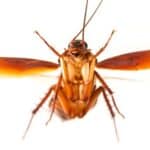Cockroaches build nests in dark and humid/damp areas near sources of food and water. They’ll live there unnoticed for weeks or months as they breed and multiply. You’ll find nests in some of the most compact and tight spaces, such as behind refrigerators, drawers, floor drains, or inside electrical outlets and appliances.
Cockroaches live together in large numbers, so destroying the nest will eliminate many of these pests at once. Clean everything up, including the egg cases (ootheca), nymphs, dead roaches, droppings, and adults. Failing to remove traces of the nest will leave a scent that attracts other cockroaches.
Getting rid of a cockroach nest will remove most of them quickly. However, you’ll need to follow up with other measures, such as vacuuming, sealing window frames, fixing broken floor drains, and drying damp surfaces.
How to Find a Cockroach Nest in Your House?
Cockroaches have species-specific nesting preferences. They also leave behind clues, such as shed exoskeletons, smearing, and poop. Use the following advice to locate where cockroaches are nesting in your home:
Cockroach Identification
Cockroaches normally build nests based on their species. According to Acta Geologica Sinica, even the earliest species in the cretaceous period gathered in nests. Today, the following apply:
- German cockroaches: Prefer tight spaces, such as moldings, crawl spaces, abd behind the fridge
- Oriental cockroaches: Water bugs like to nest near sinks, toilets, leaky pipes and damp areas
- American cockroaches: Nest near food sources, such as kitchens and pantries
- Brown-banded cockroaches: Enjoy dry and warm locations, such as cabinets and closets
Find Cockroach Hiding Spots
Cockroaches prefer to hide in dark and damp spaces with nearby food and water sources. Check:
- Behind electrical appliances, such as the fridge
- In cracks and crevices, such as the corner of rooms
- Inside or near power outlets
- Laudry rooms, especially if you have dirty clothing
- Bathrooms, especially in cabinets under sinks
- Basement and attic spaces
Locate The Nest
The easiest approach is to look for nesting signs, such as:
You can also set up sticky traps near suspicious spots. If the trap fills up quickly, the nest is likely nearby.
How to Find a Cockroach Nest Outside
Some cockroach species prefer to live outdoors, like the Oriental cockroach and wood cockroaches. Rarely do they venture into the home unless they’ve run out of food or water. Cockroaches that live outdoors like to remain undisturbed. They’ll build nests around dark and moist spaces such as:
- Underneath leaf piles
- Around compost piles and decomposing waste
- Underneath garbage bins
- Abandoned meter boxes
- Inside old sewer lines and along floor drains
- Hollow logs and loose bark on trees
- Underneath piles of wood
- House siding and wooden shingles
Although outdoor cockroaches are less of a problem, they’ll try to enter your home when they run out of food and water. Finding and destroying their nests can prevent an infestation.
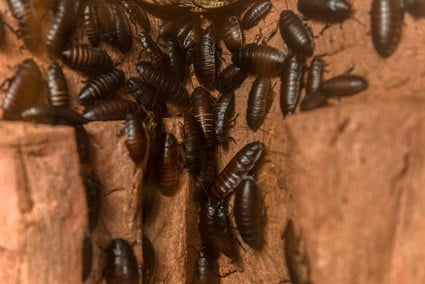
What Does a Cockroach Nest Look Like?
A cockroach nest is not a nest in the traditional sense. You shouldn’t expect bundles of twigs and leaves. Instead, the term “nest” refers to many cockroaches living together in the same place.
Cockroaches will reside in one small area, producing pheromones that attract others to their harborage. They congregate in the same place that they reproduce, lay their eggs, defecate, and hide. For this reason, it’s not easy to stumble upon a cockroach’s nest instantly. You may not see them because cockroaches come out at night.
What Does a Cockroach Nest Smell Like?
A cockroach nest has a musty and oily smell that gets stronger as the size of the infestation increases.
When cockroaches gather in colonies, they release cuticular hydrocarbons when they poop and pee. This results in a musty, pungent smell. These hydrocarbons act as pheromones, which are a type of insect scent that attracts others to the colony. Cockroaches normally release pheromones if they find a food source or want to mate.
How Many Cockroaches Live in a Nest?
A cockroach colony can accommodate anywhere between a few dozen to several hundred live and dead cockroaches. A well-established nest is a sign of a serious infestation, no matter how many cockroaches you find. They reproduce rapidly and can create large colonies within weeks.
For example, a female American cockroach can produce up to 2 egg capsules per week after mating. The female can also store sperm in her reproductive system. So, she only needs to mate once to lay future ootheca filled with eggs.
Females lay up to 16 ootheca in their lifetime. Each ootheca can hold up to 16 eggs. With an incubation period of 4-8 weeks, it’s easy for 10-20 cockroaches to reproduce quickly and become a colony of several hundred cockroaches.
Where Do Cockroaches Make Their Nests?
Cockroaches prefer to nest near sources of food and water that are warm, dark, and moist. They also prefer to nest in undisturbed spaces. Here are some of the favored nesting places for cockroaches:
Kitchen
The kitchen is a favorite spot due to its proximity to food and water. The pantry may offer easy access to readily available food in the form of:
- Decaying leftovers
- Crumbs
- Other organic matter in unwashed dishes
You may find cockroaches gathering:
- Under stoves
- Behind the refrigerator
- Anywhere undisturbed
Inspect every corner of your kitchen, including:
- Cabinets
- Underneath sinks
- Beneath unused appliances such as coffee makers
- Behind and inside large appliances, such as dishwashers
These places provide a hospitable environment for cockroaches to hide and avoid detection.
Bathroom
Many people overlook cockroaches inside the bathroom, assuming that there’s no food for cockroaches to be found. However, the bathroom is another hospitable location for these pests. It’s warm and moist, and it often remains undisturbed. The bathroom also offers food in the form of:
- Algae
- Fungi
- Soap residue
- Toilet paper
It’s a good source of water, especially if you have leaks and broken pipes. You can find cockroach nests:
- Under the bathtub
- Inside medicine cabinets
- Behind tiles
- In plumbing fixtures
Laundry Room
Laundry rooms are warm and moist, creating ideal conditions for nesting. Even though the laundry room may have few primary food sources, it provides the ideal hiding place. According to the University of Minnesota, cockroaches can feed on almost anything. This means they can thrive in a laundry room as well, feeding on:
- Cardboard boxes
- Glue
- Leather
- Cloth fibers
You should check for cockroach nests:
- Behind and inside washing machines
- In cracks and crevices in the wall
- Along pipes and plumbing fixtures
Floor Drains
Cockroaches live inside floor drains because they’re safe and a means of accessing the food and water they need. They may opt to nest in the drain if it remains undisturbed for several weeks. To prevent nesting and keep other cockroaches away, consider getting drain covers. Seal all crevices around downpipes in the wall.
Basement
A basement is an ideal place for cockroaches to establish their colonies. This space usually goes undisturbed for weeks or months. The expansive space makes the basement conducive for several nesting spots. Moreover, it’s dark and humid, with food for cockroaches to eat. Remember, cockroaches can feed on anything, including:
- Books
- Old newspapers
- Cardboard
Outdoors
Some cockroaches prefer to live outdoors and only venture into the home in search of food and water, such as Oriental cockroaches. You’ll find them nesting:
- Around garbage cans
- Near decaying matter
- Beneath leaf piles
- In porches
- In pipe ducts
- Underneath stones
How Do Cockroaches Build Their Nest?
As mentioned, roach nests are merely a gathering of cockroaches in one place. They build their nests by converging as if they are having a meeting of sorts. Roach colonies can expand to include dozens or hundreds of cockroaches.
They do not require any special materials or structures to create a proper nest. Instead, they’ll congregate in a dark and moist spot, either inside or outside the house.
Where Do Cockroaches Make Their Nests?
Cockroaches make their nest in warm and humid areas near sources of food and water. Some roaches prefer cooler temperatures. However, their hiding spots must still be moist and closer to food for the sake of their survival. You may find cockroach nests in:
- Cracks and cavities
- Beneath your furniture
- Behind your refrigerator
- Underneath leaf piles
- In closets
How to Get Rid of a Cockroach Nest
If you find a cockroach nest in your home, your need to act immediately as cockroaches move quickly. Once they get away, they’ll form a new nest elsewhere in your home. Follow these steps:
Spray Insecticides And Pesticides
A quick way to kill a cockroach colony is to spray the nest with chemicals. This will destroy all the cockroaches in that nest that are coated in the spray, although some have become immune to insecticides.
Set Up Sticky Traps And Bait Stations
Setting up traps and bait stations can reduce cockroach infestations. These stations consist of a food source combined with slow-killing insecticides. When a cockroach ingests the poisoned food, it will go back to its nest and spread the insecticide to other cockroaches. These can be beneficial if there are other undetected nests.
Apply Diatomaceous Earth
Diatomaceous earth is a natural insecticide derived from fossilized algae. It’s toxic to all insects that have an exoskeleton. It won’t kill cockroaches instantly. Applying it near cockroach harborages will kill cockroaches over the next few days to weeks due to dehydration.
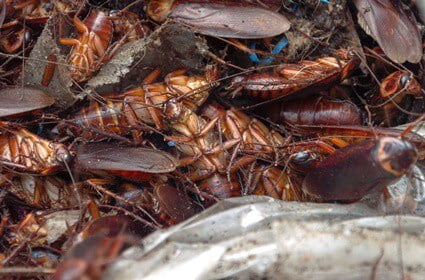
Clean Up Everything
Vacuum everything, including:
- Egg capsules
- Dead roaches
- Droppings
- Cockroach nymphs
This will remove any traces of the infestation. Then, clean the area with bleach to get rid of the ‘death scent.’ Without pheromones, the area is less likely to attract other cockroaches.
Seal All Openings
Once the cockroaches are dead or gone, seal all openings. These may exist between your doors and window frames, as well as between your walls and ceiling. Cutting off access points will reduce the chances of reinfestation.
How Do I Get Rid of Cockroach Nest Smells?
Insects use different odors to communicate. Because of this, the smell of a cockroach nest can invite other cockroaches into your home. Here’s how:
Remove Dead Roaches And Their Feces
Dead cockroaches release linoleic acid (fatty acids) from their decomposing bodies. The smell may act as a pheromone to alert other cockroaches of impending danger.
Likewise, cockroach feces contains pheromones that attract other cockroaches. So, vacuum up any dead cockroaches and feces to remove the smell and prevent reinfestations.
Clean Black Spots And Roach Droppings
Dark spots, smears, droppings, and mounds of cast skins are all signs of a cockroach nest. These emit a pungent smell that is attractive to other cockroaches. Cleaning the dark spots and smears with bleach can remove the smell.
Dry Any Damp Surfaces
The droppings and feces of cockroaches can attract mold, which produces its own distinct smell. There’s a symbiotic relationship between cockroaches and mold. The smell can become stronger if you leave your surfaces damp and wet. Cleaning and drying moist surfaces can remove the scent and prevent roaches from invading your home.
Maintain Cleanliness In All Spaces
Even after cleaning up, some cockroaches may return to the nesting area to create a new colony. To prevent this from happening, maintain high standards of cleanliness. Declutter your space, store food properly and seal all cracks.
How To Prevent Cockroach Nests
Once a nest is established, it’s difficult to find and remove it. With that in mind, use preventative measures. Here are ways to keep roaches from nesting in your home.
Seal Cracks And Crevices
Cockroaches like to build their nests in between cracks, crevices, and wall cavities. So, seal all visible gaps in your home. Start by fumigating all the cracks and apply insecticidal sprays before sealing the spaces with a filling agent.
Fix broken Pipes And Fixtures
While cockroaches can live for up to 30 days without food, they cannot survive for more than 2 weeks without water. By fixing leaking pipes and broken fixtures, you’ll cut off their water supply, forcing them to relocate.
Cover Floor Drains
Cockroaches rarely build nests in floor drains. However, they may do so in rarely used or abandoned drains. Cockroaches do enter homes via drain pipes. So, cover your floor drains to keep cockroaches out and prevent nesting.
Organize Your Garage Or Basement
Leaving your basement or garage full of clutter and cardboard boxes will attract cockroaches. The dark corners coupled with the clutter create an ideal environment for cockroaches to build their nests.
Citrus-Scented Cleaners
The strong smell of citrus works as a repellent against cockroaches. So, use citrus-scented cleaners in your bathroom, kitchen, and other places. This will keep cockroaches away and stop them from building nests.
Wipe Away Spills Immediately
A spill may appear harmless at first, but it’ll attract cockroaches to your home. According to the University of Florida, cockroaches have a strong sense of smell. They can use their antennae to find the exact spots where you left spills uncleaned. One cockroach will release pheromones and attract many others.
Keep Leftover Food In Airtight Containers
Keep perishables in the refrigerator and put any leftover food in airtight containers. Also, avoid dropping crumbs on the floor and always clean your countertops after preparing food.
Dispose Of Your Garbage And Trash
Your trash cans and garbage bins are favorite spots for cockroaches. After all, they prefer eating decomposing food and decaying matter. Never let your trashcans overflow, and cover the empty bin with tight lids.
If you find a cockroach nest, you need to act quickly because they’ll quickly disperse to other areas. When performing your search, ensure that you have a can of insecticide spray next to you. Clean the area thoroughly when done and put down cockroach traps to prevent them from returning to the area.
